NEC MultiSync P461 Review
NEC MultiSync P461
Is this 46in LCD screen with a built-in Atom PC the real Smart TV deal, or a convergence bridge too far?
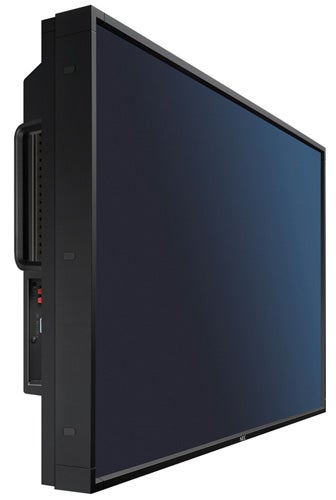
Verdict
Last week fellow TrustedReviews writer Gordon took the wind out of many big AV brand sails by passionately railing against the growing ‘Smart TV’ trend. And his extremely lucid article was then followed by a truly startling show of supportive comments from you, the TrustedReviews readership.
One of these comments in particular caught our eye. ”MrHorizontal” suggested that anyone interested in a ”really” ‘smart’ TV should take a look at one of NEC’s P Series of LCD screens designed for the Public Display market, for it’s possible to integrate into these a fully functioning PC via a simple slot-in optional board.
”MrHorizontal’s” comment concluded by suggesting that we review one of these NEC monitors as if it were a normal TV. So we thought we’d strike while the iron was hot and do exactly as he suggested!
For people not familiar with NEC, it predominantly operates these days in the business marketplace, selling screens for public display or signage projects. But the screens can be bought easily by anyone over the Internet, so if you wish you can also use them in your home.
In terms of the P461‘s key PC functionality, all we had to do to insert the PC board was remove two screws from a cover down the TV’s rear right side, take off one of the set’s screw-on carry handles, and slide the SBC (single board computer) home. This is something absolutely anyone can do, with no professional help required.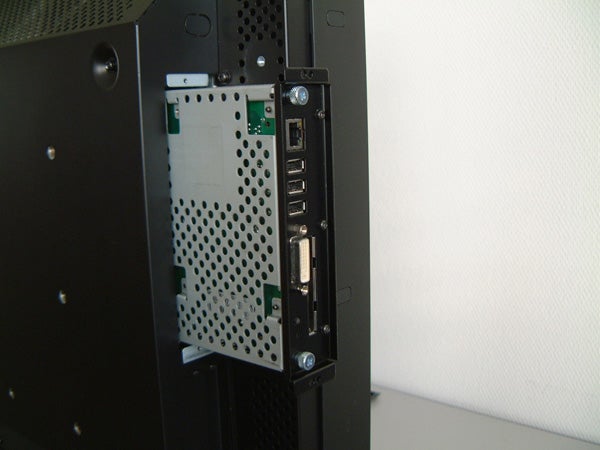
If you raised an eyebrow at the mention of a detachable handle on the P461, then you should know that this is just one physical sign of the P461’s ‘professional’ rather than domestic background. For it also happens to be the fattest darned TV we’ve seen in an age – a full 140mm from front to back. Plus it weighs a hefty 36.1kg weight – around double the normal weight of today’s 46in TVs.
It has to be said, too, that the P461’s ‘business’ focus means it’s not exactly gorgeous. That colossal rear is about as brutishly industrial as you can get, while the bezel is a style-free plain matt black affair. Please note, too, that the screen doesn’t ship with any speakers in its standard state; if you want sound without using an external audio system, you’ll need NEC’s optional P Series stereo speakers (pictured below).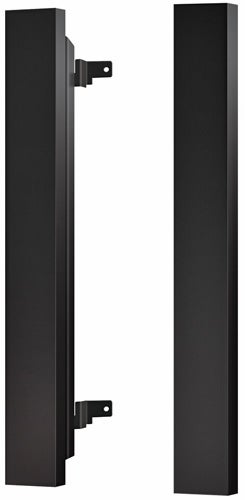
The P461 isn’t a total aesthetic washout, though, for the bezel is, at least, very slim as you look straight at it. Also, there’s no doubting that the P461’s build quality feels almost tank-like – handy if you’ve got a few young kids charging about the place.
The hefty rear isn’t just there because NEC couldn’t be bothered to make it small, either. For as well as providing room to slot in the Atom PC, the P461’s potential for professional use also means it carries temperature-controlled cooling fans.
This was initially worrying, to be honest, given how much racket cooling fans can make. But thankfully we never once heard them running throughout our time testing the screen. 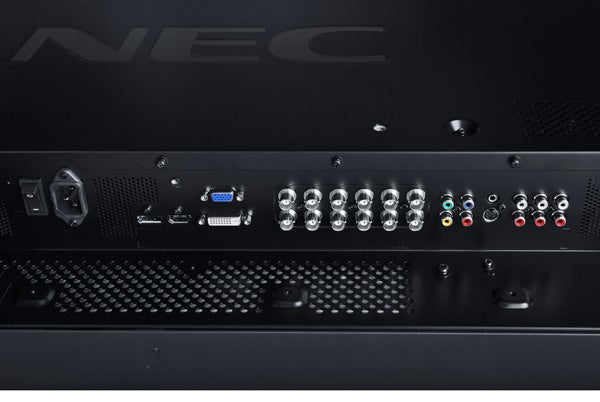
You might have noticed that we keep referring to the P461 as a screen rather than a TV. This is because the P461 doesn’t come with a tuner fitted as standard.
At this point, it’s worth reminding everyone why we’re prepared to put up with so many non-domestic compromises: the built-in PC access. It’s this that makes the screen interesting in the Smart TV age.
Connections on the P461 useful for home cinema use are pretty much limited to only one HDMI, an S-Video port, a component video port, and a D-Sub PC port. Though there is also a second digital option in the form of a Digital Display port 1.1 if that works with your PC.
You could also have added other jacks via the upgrade bay, including a pro-grade HD-SDI board and a CAT 5 receiver, if you hadn’t already eaten the slot up with the Atom PC board!
Naturally, this PC board also includes an Ethernet port, as there wouldn’t be much point having a PC in a screen these days without it having the facility to get online.
Heading into the P461’s setup menus uncovers some unexpectedly impressive stuff. There’s a dedicated Black Level adjustment, for instance, with 100 levels of fine tuning. Even better, there’s an option to adjust the colour temperature in 100-Kelvin steps all the way from 2,600k to 10,000k. Naturally, this includes a stop point at the 6500K level generally reckoned to be the best for video playback.
You can further fine-tune the red, green and blue gain levels within the colour temperature section, as well as the general saturation levels of the red, green, blue, cyan, magenta and yellow colour elements.
As if all that wasn’t enough, you get a set of gamma presets including a native one and the 2.2 setting we favour, plus you get the option to turn on or off an adaptive contrast system. This defaults to Off, showing some confidence from NEC in the natural contrast performance of its screen. 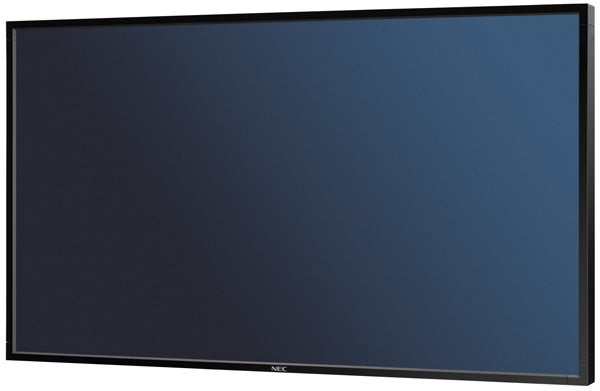
This really does add up to an impressive suite of calibration tools for a screen not specifically aimed at domestic users, and it allows you to achieve some dramatic effects on the picture.
The only issue we’d take with the settings is that the Movie picture preset provided on our sample seemed way off our idea of a good movie setting. It pushed brightness much too hard, so that the picture emphasised noise and lacked contrast.
More sensibly calibrated, though, the P461 produces a picture considerably better than we’d anticipated. Our experience of public display LCD screens previously has suggested that – quite understandably – they tend to push dramatic brightness and OTT colours ahead of the subtler approach necessary for optimum domestic viewing. But crucially, the P461 has enough flexibility with its settings to calm it down from its ‘shop’-oriented over-aggressive starting point to a level where it’s actually very watchable with films too.
The single biggest shock finds the P461 able to produce colours of striking authenticity and subtlety. Its colour palette seems extensive, skin tones look believable, but the picture always still looks dynamic and lush.
This is helped by the set’s predictably extreme brightnesss output – but thankfully, you can rein this in until it actually looks right for a home rather than ‘public’ forum. Even better, during pictures with a mixture of light and dark content, the screen even seems able to produce a decent degree of black level response to provide a strong foundation for the colour pyrotechnics to operate against.
HD pictures look extremely sharp and detailed too, with the screen doing an excellent job of reproducing the slightly grainy look deliberately delivered by some high quality Blu-ray film transfers.
Its sharpness, brightness, and colour accuracy enable the P461 to deliver a good sense of depth and scale with a high quality HD image. In fact, at times there’s a near-professional mastering grade of finish to some aspects of the picture.
Pity, then, – if hardly a surprise – that the screen struggles in one or two other fundamental areas. First, when watching a predominantly dark scene rather than one that’s mostly bright or more of a mix, there’s a really quite grey, milky look to picture parts that should be black. This is apparent even after calibration.
You can improve things by really knocking down the backlight setting, but actually, doing this out of the context of a full, picture-wide calibration results in a picture that looks unbalanced and which is almost completely devoid of shadow detailing.
So we left the black level and brightness settings at the point where they worked best for the picture as a whole, even though this meant that the grey misting remained.
There’s a little inconsistency in the levels of this greyness too, if we were being really picky. But not as much as seen with some rival screens recently.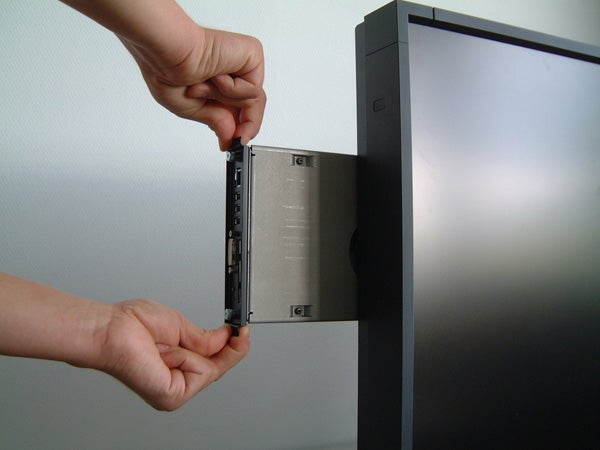
The picture’s other main problem is with motion handling. Not blur, mind you; that’s actually handled extremely well. Rather the issue is with judder, which is particularly apparent with Blu-rays regardless of whether you have the provided Auto-Film setting on or off.
It won’t have escaped your notice, of course, that we haven’t even mentioned the all-important built-in PC capabilities yet. But actually, this is a good thing! For the simple fact of the matter is that the P461’s Intel Atom module really does give you a fully functioning 1.6GHz PC with 1G RAM and 230GB of HDD space tucked neatly within your main living room screen. It’s as simple as that. The only thing missing is a disc drive.
But then the module even gives you three USB ports (one of which will have to be used for attaching a mouse) for adding pretty much what you like, as well as an ExpressCard slot you could use for adding a DVB-T tuner by the back door. 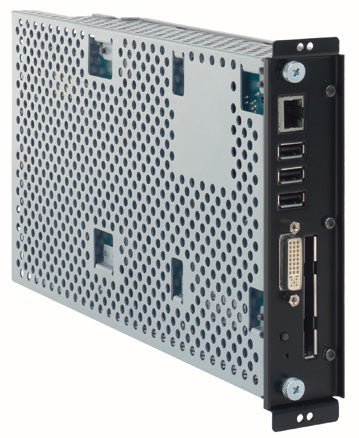
There can be no doubt whatsoever, then, that in functionality terms the P461’s interactive offering is enough to leave Smart TVs looking like the total waste of space many people seem to believe they are. And yet…
Somehow, it didn’t really work for us. As Gordon pointed out in his Idiocy of Smart TVs opinion piece, the reality of having a full PC built into a TV was fun for a few hours, but then pretty soon made us realise just how little we want a full PC built into a TV. While the full PC TV concept may work for some very tech-minded people – like, no doubt, ”MrHorizontal” – we feel confident that the worlds of the full PC and TV are just too far apart in terms of both their interfaces and, more importantly, their ‘social spaces’ to fit together for a mainstream TV audience.
Verdict
Reviewing the P461 has been an unexpectedly interesting experience, in that it’s actually taught us a couple of things. First, we now know that the Public Display screen market is not nearly as far away from satisfying the needs of the domestic market as it used to be. Second, it’s taught us – or perhaps I should fairer say, me – some (possibly unpopular!) things about my feelings regarding Smart TVs that I intend to cover in detail at some point in the next few days.
Focusing on the screen itself for now, though, while the P461 has definitely performed better than we’d expected and certainly can’t be knocked for its unprecedented multimedia/PC possibilities, only the most PC-centric of people could deny that there are aspects of its overall performance, its design and its price that don’t ultimately feel at home in the living room.
This is hardly NEC’s fault, of course; in response to ”MrHorizontal’s” astute suggestion, we’ve really been testing the P461 in a role it wasn’t designed to fulfil. As a public display screen, we’d actually consider the P461 to be rather good, certainly for its money. Plus, of course, we’re already bracing ourselves for that ‘PC-centric’ community mentioned above and probably reading this site to start defending the P461 in their droves…
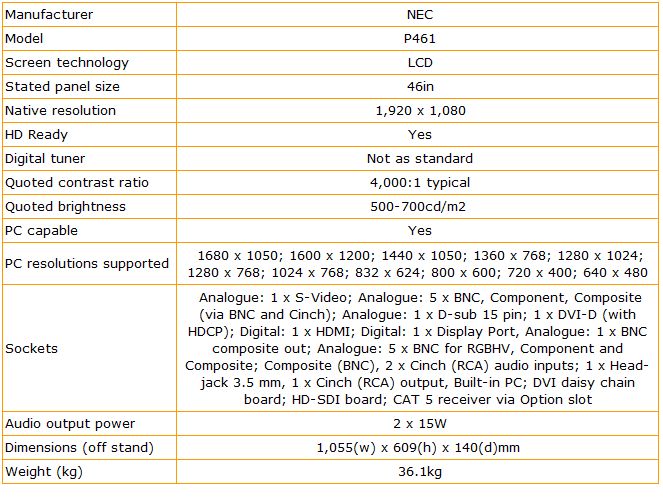
How we test televisions
We test every TV we review thoroughly over an extended period of time. We use industry standard tests to compare features properly. We’ll always tell you what we find. We never, ever, accept money to review a product.
Trusted Score
Score in detail
-
Features 8
-
Value 5
-
Image Quality 7
-
Design 6
Features
| Size (Inch) | 46in |
| Display Type | LCD |

